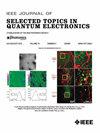Unpolarized Nonreciprocal Thermal Emitters Based on Generalized Transverse Magneto-Optical Effect
IF 5.1
2区 工程技术
Q1 ENGINEERING, ELECTRICAL & ELECTRONIC
IEEE Journal of Selected Topics in Quantum Electronics
Pub Date : 2025-07-17
DOI:10.1109/JSTQE.2025.3590100
引用次数: 0
Abstract
In optics and thermal photonics, reciprocity governs and constrains the transportation of light and thermal radiation. Transverse magneto-optical effect is the main mechanism to break reciprocity in propagation, reflection, absorption, and emission. However, it is well-recognized that transverse magneto-optical effect is only valid for transverse magnetic polarization, which is the fundamental constraint in realizing unpolarized or polarization-independent nonreciprocal photonics and thermal photonics. Although the recent reports demonstrate the dual-polarized nonreciprocal thermal emitters based on the rotated incident plane and multimode interaction, it is still unclear the general principle behind a myriad of magnetic configurations and microstructures. More importantly, current dual-polarized thermal emitters are still limited with the non-overlapping angular and spectral properties for both polarizations. In this paper, we reveal the transversal inhomogeneity and the transverse wave nature of light are the generation mechanism of dual-polarized nonreciprocity in arbitrary magneto-optical structures, which is the manifestation of the generalized transverse magneto-optical effect. Moreover, one-dimensional Weyl-semimetal materials-based grating is designed to demonstrate the strong and broadband nonreciprocal thermal radiation, exhibiting an enhanced nonreciprocal radiative heat transfer efficiency superior to the ideal single-polarized nonreciprocal thermal emitters. Our results pave the avenue to unpolarized nonreciprocal photonics and thermal photonics.基于广义横向磁光效应的非极化非互易热辐射体
在光学和热光子学中,互易控制和限制光和热辐射的传输。横向磁光效应是光子在传播、反射、吸收和发射过程中破坏互易的主要机制。然而,众所周知,横向磁光效应仅适用于横向磁极化,这是实现非极化或与极化无关的非互易光子和热光子的基本限制。虽然最近的报道显示了基于旋转入射面和多模相互作用的双极化非互易热发射体,但仍不清楚无数磁构型和微观结构背后的一般原理。更重要的是,当前的双极化热发射体仍然受到两种极化的角度和光谱特性不重叠的限制。本文揭示了光的横向非均匀性和横波性质是任意磁光结构中双极化非互易的产生机制,这是广义横向磁光效应的表现。此外,基于一维weyl -半金属材料的光栅显示出强且宽带的非倒易热辐射,显示出比理想的单极化非倒易热辐射器更强的非倒易辐射传热效率。我们的研究结果为非极化非互易光子学和热光子学的发展铺平了道路。
本文章由计算机程序翻译,如有差异,请以英文原文为准。
求助全文
约1分钟内获得全文
求助全文
来源期刊

IEEE Journal of Selected Topics in Quantum Electronics
工程技术-工程:电子与电气
CiteScore
10.60
自引率
2.00%
发文量
212
审稿时长
3 months
期刊介绍:
Papers published in the IEEE Journal of Selected Topics in Quantum Electronics fall within the broad field of science and technology of quantum electronics of a device, subsystem, or system-oriented nature. Each issue is devoted to a specific topic within this broad spectrum. Announcements of the topical areas planned for future issues, along with deadlines for receipt of manuscripts, are published in this Journal and in the IEEE Journal of Quantum Electronics. Generally, the scope of manuscripts appropriate to this Journal is the same as that for the IEEE Journal of Quantum Electronics. Manuscripts are published that report original theoretical and/or experimental research results that advance the scientific and technological base of quantum electronics devices, systems, or applications. The Journal is dedicated toward publishing research results that advance the state of the art or add to the understanding of the generation, amplification, modulation, detection, waveguiding, or propagation characteristics of coherent electromagnetic radiation having sub-millimeter and shorter wavelengths. In order to be suitable for publication in this Journal, the content of manuscripts concerned with subject-related research must have a potential impact on advancing the technological base of quantum electronic devices, systems, and/or applications. Potential authors of subject-related research have the responsibility of pointing out this potential impact. System-oriented manuscripts must be concerned with systems that perform a function previously unavailable or that outperform previously established systems that did not use quantum electronic components or concepts. Tutorial and review papers are by invitation only.
 求助内容:
求助内容: 应助结果提醒方式:
应助结果提醒方式:


